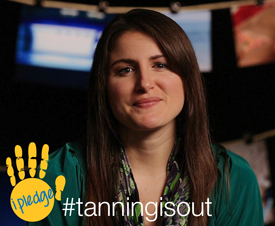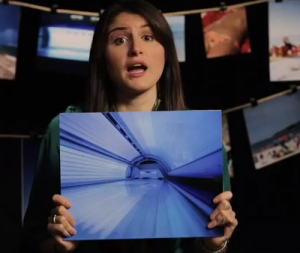 “For me, I always thought to look attractive and healthy you needed that dark tan glow. To come to terms with being fare-skinned was rough. It’s weird looking in the mirror and seeing a lighter skin color looking at me. But what made me stop tanning was when I got cancer. People don’t think of the future consequences and how draining having cancer is. I stopped tanning because of the surgeries- the amount of surgeries and the amount of money and time. Every Friday I would have to get my skin checked and check out my stitches from surgery. Now I still have to go to the dermatologist every six months. I wish I took care of myself instead of having cancer be my wake up call.”– Joanna Confalone, 29.
“For me, I always thought to look attractive and healthy you needed that dark tan glow. To come to terms with being fare-skinned was rough. It’s weird looking in the mirror and seeing a lighter skin color looking at me. But what made me stop tanning was when I got cancer. People don’t think of the future consequences and how draining having cancer is. I stopped tanning because of the surgeries- the amount of surgeries and the amount of money and time. Every Friday I would have to get my skin checked and check out my stitches from surgery. Now I still have to go to the dermatologist every six months. I wish I took care of myself instead of having cancer be my wake up call.”– Joanna Confalone, 29.
Confalone’s Deadly Tanning Story
Joanna Confalone, a 25-year-old Northeastern grad student at the time, had just arrived at Wingaersheek Beach, Mass. to spend the summer weekend at her mother’s shorefront beach house where she planned to slip into her two-piece bathing suit for the next couple of days. She was excited to go back to work the following Monday with a real summer glow instead of having an artificial tan from Tanorama Suntanning Center, a Boston salon she visited about three times a week after work. But before stepping onto the beach, Confalone’s doctor called, and suddenly she decided to keep her bathing suit folded up in her travel bag for the entire weekend.
Just five days before the doctor called to break the news, Confalone had a black mole the size of a “No. 2 pencil eraser” removed from her leg, a mole she had been overlooking for months. She didn’t think it was serious but when she learned that it was, she was too shocked to respond to her doctor who was listing off what the next steps were to fighting the melanoma she had developed. All that was going through her head was, “Melanoma, melanoma, how do I have melanoma?”
“She told me that me fake tanning all these years caused my cancer,” says Confalone, who added that she regularly scheduled in a 20-minute tanning session three or more times a week in high school, and later continued her
tanning regimen throughout college. “I never thought once that I would be a cancer patient.”
Like Confalone, over one million young adults in the United States ignore the potential consequences of using tanning beds because they often think they are invincible when it comes to getting skin cancer. In most cases, fake tanning is just another item to cross off on some of these fake-n-bakers’ daily to-do lists, along with going to school, work, and doing laundry. But statistcs show that, obviously, tanning is a tad bit extremely more dangerous than just folding freshly clean clothes from out of the dryer.
“Young people generally feel it’s not going to happen to them and it does,” says Deb Girard, the executive director of the Melanoma Foundation of New England, an organization that provides educational programs to raise awareness about skin cancer. “The UV rays of the tanning beds cause cancer.”
… And many studies can prove the deadly consequences of fake tanning, but still, people choose to ignore them. According to the Skin Cancer Foundation, “people who first use a tanning bed before age 35 increase their risk for melanoma by 75 percent, and among people ages 18 to 29 who have ever used a tanning bed and were diagnosed with melanoma, 76 percent of those melanoma cases were attributable to tanning bed use.”
These are just a few out of hundreds of statistics that prove how dangerous tanning beds are, and I could go on and on listing them out for you, but like I said before, many people choose to ignore these facts, and I don’t think it takes numbers to make people realize these extremely real consequences… I think it takes people to realize it when it’s too late.
Unfortunately for Confalone, the consequences were real once they actually happened to her. Now, after five surgeries that left behind several four-to-seven-inch scars on her legs and back, Confalone is reminded every day of the deathly consequences of artificial tanning and is still paying for her tanning-bed ritual.
“Even though I’m melanoma free, I still have to go in for check ups every four to six months,” says Confalone who will be cancer free for five years this summer. “All the doctors appointments and surgeries are not worth it.”
Here’s a powerful video Confalone was in that was produced by the Melanoma Foundation of New England. These are real people, real stories, and most importantly, real consequences of that oh-so popular trend of fake tanning.
_______________________________________________________
I first met Joanna Confalone, a 29-year-old marketing and research associate at McCall and Almy, my freshman year in college when I was writing my very first magazine-style article about “tanorexic” college students. Prior to writing the article, I, myself, was a fake-tanner and had gone twice a week for about a year. After speaking to a real melanoma survivor, I realized that I needed to stop while I was ahead. The consequences are very real, I could have been another young adult getting treated for a deadly cancer. One thing that really resonated with me while I was interviewing her was when she told me that her experience with cancer made her realize that fake tanning was selfish because of the anxiety, stress and pain she caused her family and friends while fighting cancer. It made me think, yeah, even though tanning was my own choice and it directly affected me, it could be my own choices that directly affect the people closest to me, too. It’s one thing causing myself pain, but causing pain to others is something else. I would never want my mom to cry over the medical bills she would have to help pay for in order to keep me alive, or even worse… mourn because I’m no longer here. I stopped fake tanning because Confalone made me realize we have one body, pale or tan, and it’s not worth damaging it for a certain look. And we have one life, and it’s our responsibility to make it a healthy one.

